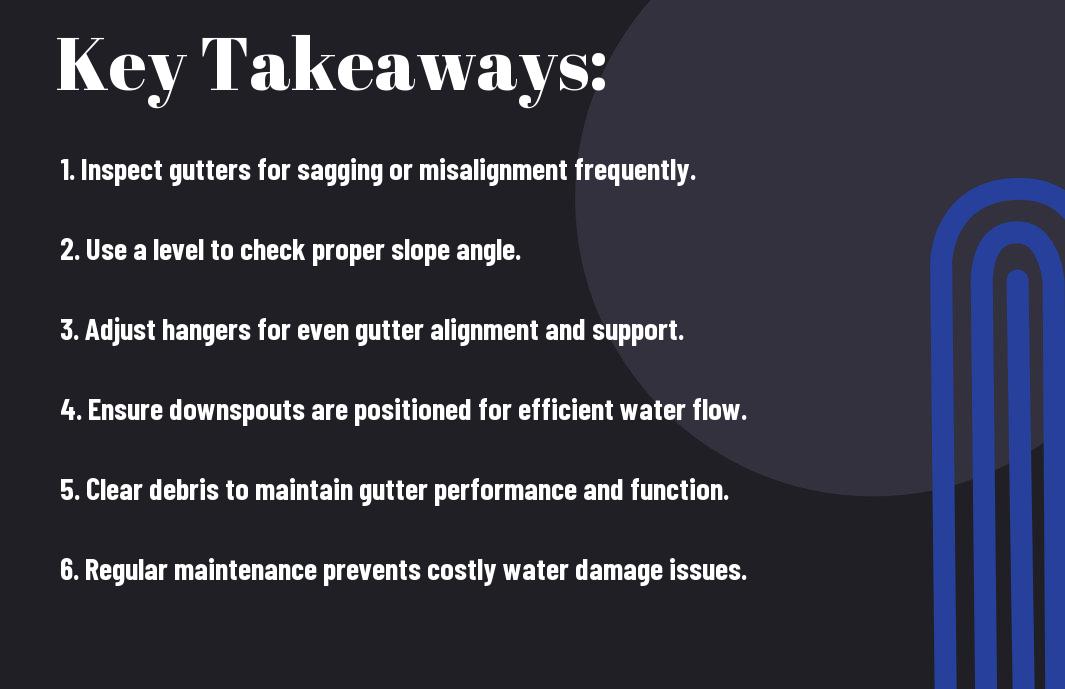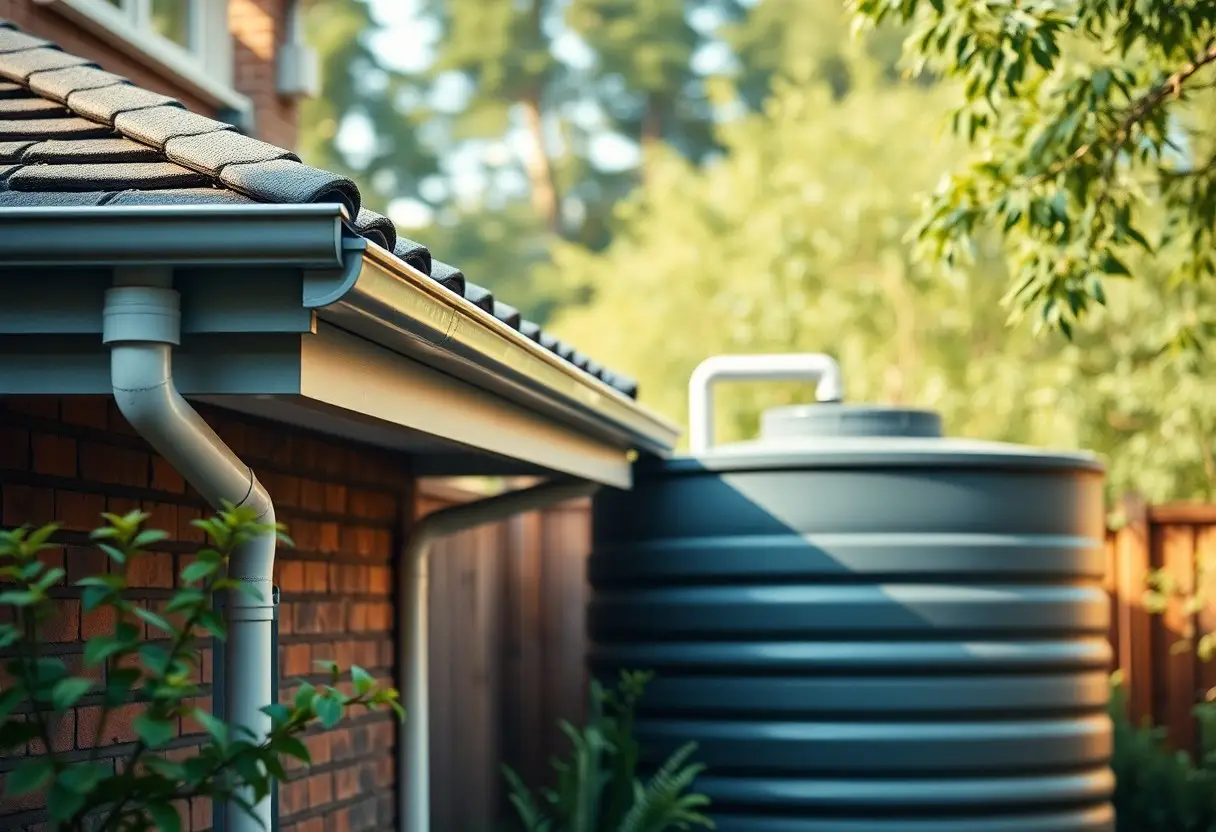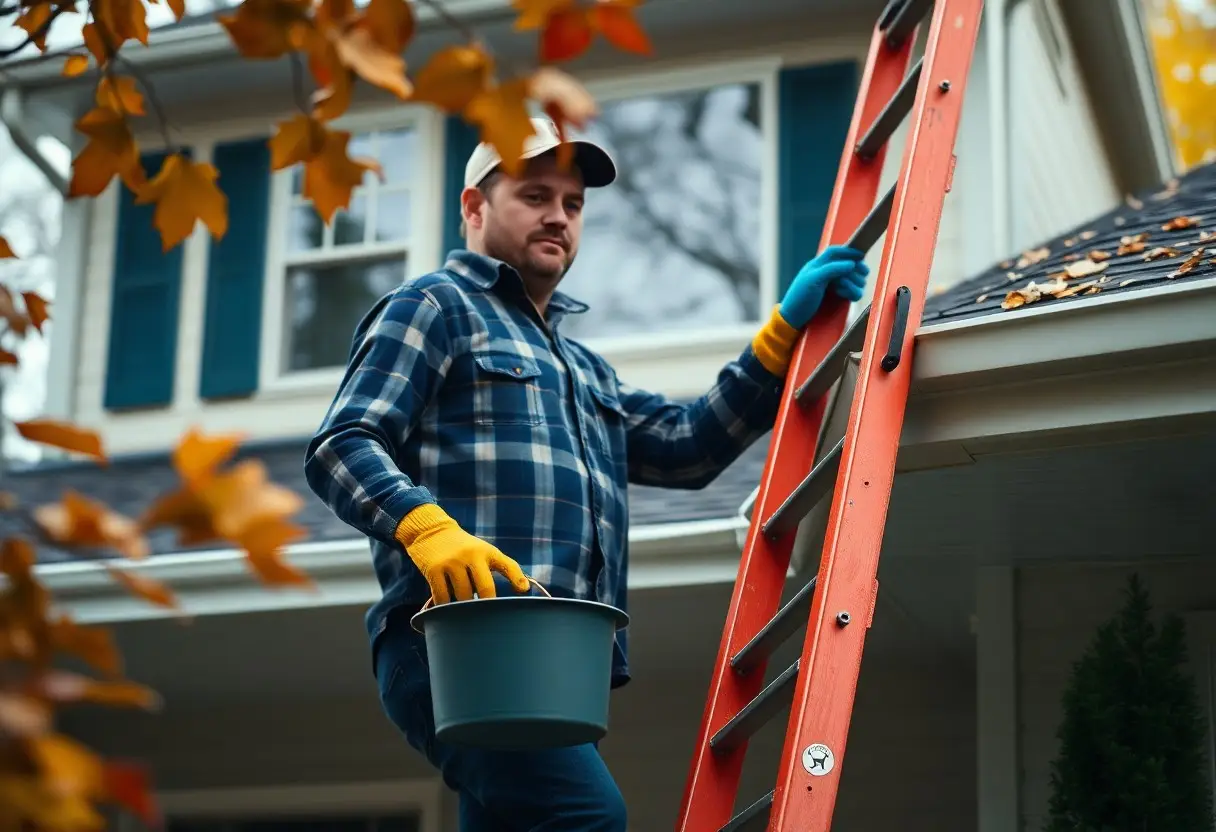Over time, your gutters can fall out of alignment or lose their slope, which can lead to serious water damage to your home. Understanding how to adjust gutter alignment and slope is imperative for optimal performance. In this post, you’ll learn simple techniques to inspect your gutters, determine the appropriate slope, and make adjustments that will ensure they efficiently channel rainwater away from your foundation. With these tips, you can protect your property while enhancing your gutter system’s longevity.
Key Takeaways:
- Proper alignment of gutters is necessary to prevent water pooling and ensure efficient drainage away from the home.
- Establishing a slight slope towards the downspout, typically a quarter inch for every ten feet, helps facilitate smooth water flow through the system.
- Regular maintenance checks should be conducted to identify any misalignment or blockages that can hinder gutter performance.
Importance of Proper Gutter Alignment
Before you can ensure your gutter system operates effectively, proper alignment is key. Misaligned gutters can lead to a myriad of problems, including ineffective water runoff and potential damage to your home’s foundation. By maintaining the correct slope and alignment, you can help ensure rainwater flows smoothly away from your property, preventing a range of issues that can arise from stagnant water.
Preventing Water Damage
One of the primary reasons for maintaining proper gutter alignment is to prevent water damage to your home. When gutters are not aligned correctly, water can overflow, pooling around your foundation and leading to potential mold and structural damage. By ensuring your gutters are aligned, you significantly reduce the risk of water accumulating and causing detrimental effects to your property.
Enhancing Gutters’ Lifespan
Enhancing your gutters’ lifespan is another vital reason to focus on proper alignment. When gutters are installed with the correct slope, they function efficiently, clearing debris and allowing water to flow freely. This reduces the amount of wear and tear, ultimately extending the life of your gutter system.
Lifespan matters when it comes to your gutter system, as well-maintained gutters can last significantly longer than those left unchecked. A well-aligned gutter system prevents blockages and excessive weight from standing water, reducing the chances of rust and damage from debris accumulation. By prioritizing alignment, you can save money on repairs and replacements, optimizing your gutter system’s performance and extending its overall lifespan.

Tools Needed for Adjustment
Some tools are crucial for effectively adjusting your gutter alignment and slope. Having the right equipment not only makes the process easier but also ensures that your gutters function optimally. You can expect to need basic hand tools, measuring equipment, and possibly some specialty items to achieve the perfect slope.
Essential Tools
Tools required for this task primarily include a level, a tape measure, a screwdriver, and adjustable brackets. A level ensures that your gutters are properly aligned, while a tape measure helps you achieve the correct slope. A screwdriver will be needed to tighten or loosen the gutter brackets as necessary. Having these tools on hand will facilitate a smooth adjustment process.
Safety Equipment
An important aspect of gutter adjustment involves using proper safety equipment. You should equip yourself with a sturdy ladder that is tall enough for your particular home, as well as gloves to protect your hands while handling the gutters. A hard hat is also recommended to guard against any falling debris, ensuring your safety during the entire process.
At all times, be conscious of your surroundings when you’re up on a ladder. Using a steady and well-placed ladder is vital to avoid accidents. Ensure that your ladder is on flat, stable ground, and if possible, have a friend hold it steady for you. Wearing gloves protects your hands from sharp edges, while a hard hat will shield your head from falling debris when working on gutters. Always prioritize safety to enjoy peace of mind while you work.
Assessing Current Gutter Alignment
To effectively adjust your gutter system, it’s necessary to start with an accurate assessment of its current alignment. Evaluating how your gutters are positioned will help you identify any issues affecting their performance. Look for any signs of sagging, pooling water, or debris buildup, as these can indicate misalignment. Consider the overall pitch of your gutters and ensure they direct water to the downspouts efficiently.
Visual Inspection Techniques
One effective method for assessing your gutter alignment is conducting a thorough visual inspection. Inspect from the ground level using a ladder for a closer look, paying attention to sections where water tends to collect. Look for straight lines and even slopes; any inconsistencies can point to potential alignment issues.
Identifying Common Misalignments
Misalignments can manifest in various ways, but common signs include visible sagging, angled sections, or sections that are too high or low. These issues can lead to water pooling and overflowing, which may damage your home’s foundation. Regular inspections will help you detect any deviations that can compromise the functionality of your gutters.
Also, checking for bellies or slumps in your gutters is vital; water pooling here can cause rust and deterioration over time. Ensure downspouts are positioned correctly to funnel water away from your home. If you notice any gaps between joints or disconnected sections, these should be addressed promptly to prevent water damage. By keeping an eye out for these misalignments, you can maintain optimal gutter performance and protect your home from potential issues.

Adjusting Gutter Slope
Once again, ensuring your gutters are properly sloped is vital for effective water drainage. The ideal slope allows rainwater to flow toward the downspouts, preventing pooling and minimizing water damage to your home. Adjusting the slope is a straightforward task that can significantly enhance your gutter’s performance, ensuring longevity and reducing the risk of leaks or overflow during heavy rains.
Measuring the Slope
Among the key steps in adjusting your gutter’s slope is accurate measurement. Use a level or a measuring tape to find the current pitch of your gutters, which should typically have a slope of 1/4 inch for every 10 feet. This measurement will help you determine how much adjustment you need to make for effective water flow.
Techniques for Adjustment
Above all, several techniques can be employed to adjust your gutter slope effectively. You can raise or lower the mounting brackets to achieve the correct pitch. Furthermore, you might also need to reposition downspouts to ensure they are at the lowest point of the slope for optimal water flow.
In addition, using shims can be a helpful technique to adjust the angle of your gutters easily. By placing shims under the mounting brackets, you can create the desired slope without the need for extensive rerouting. If you find your gutters need significant adjustment, carefully detach them and reposition them entirely, ensuring they maintain a consistent pitch along their length. It’s vital to check for any blockages in the downspouts afterward, as they can hinder drainage despite the correct slope. Implementing these techniques will ultimately lead to better water management and protect your home from potential damage.
Securing Gutters After Adjustment
Unlike the initial installation, securing your gutters after adjusting their alignment and slope is vital for ensuring long-term effectiveness. Once you’ve made the necessary adjustments, double-check the positions, and use appropriate fastening techniques to maintain their stability. This will help prevent any sagging or misalignment caused by heavy rain or debris accumulation, ensuring your gutters function optimally.
Fastening Methods
Below are several reliable fastening methods you can use to secure your gutters effectively. Options include using gutter brackets, screws, or spikes, depending on your gutter type and material. Make sure to tighten these fasteners adequately to hold your gutters in place, preventing any potential leaks or separation points that could arise over time.
Regular Maintenance Practices
The importance of regular maintenance practices cannot be overstated when it comes to ensuring your gutters remain in optimal condition. Make it a habit to clean your gutters at least twice a year, checking for debris, blockages, and signs of wear. This proactive approach not only enhances the performance of your system but also helps you catch small issues before they develop into more significant, costly repairs.
After securing your gutters, establishing a consistent maintenance routine is vital for avoiding serious problems. Inspect your gutters regularly for any clogs, rust, or damage, and clear away debris to allow for proper water flow. Additionally, check for any signs of leaks, as unresolved issues can lead to water damage to your home’s foundation or siding. By staying vigilant with your maintenance, you’re ensuring not only the safety of your home but also the efficiency of your gutter system.
Can Installing Gutter Guards Help Maintain Proper Gutter Alignment and Slope?
Installing gutter guards effectively can significantly enhance the longevity and performance of your gutters. By preventing debris buildup, they help maintain proper gutter alignment and slope, reducing the risk of overflow and damage. This proactive approach ensures that water flows smoothly, safeguarding your home’s foundation and exterior.
Troubleshooting Common Issues
Not addressing gutter issues promptly can lead to more significant problems in your home. Regular inspection is important to maintain your gutter system’s efficiency. Typical signs may include water pooling around your foundation, sagging gutters, or rust and corrosion. Keeping an eye on these symptoms helps you take corrective measures before they escalate.
Signs of Poor Performance
Across your property, you may notice excessive water runoff, stagnant water in the gutters, or the presence of pests and mold. These are indicative of poor gutter alignment and slope. Discoloration on your building’s exterior and the soil erosion around your foundation can also signal that your gutters are not performing as they should.
Solutions to Common Problems
Poor alignment or slope can lead to significant issues such as overflow, leaks, or even structural damage. It’s important to take swift action when you notice these problems. Adjusting your gutters to ensure they have the appropriate pitch will allow water to flow effectively toward the downspouts. Additionally, regularly cleaning your gutters and downspouts will prevent blockages that contribute to inadequate performance.
Hence, addressing these common problems can prevent further damage to your home. Begin with regular inspections to identify any signs of inefficiencies such as clogs, misalignment, or even gaps. Next, ensure your gutters slope at least 1/4 inch per 10 feet toward the downspouts. If you encounter sagging sections, you may need to add additional hangers to support them properly. With these proactive measures, you can enhance your gutter system’s performance and protect your property from water damage.
Final Words
Following this guide, you can effectively adjust your gutter alignment and slope to ensure optimal performance. By checking for proper pitch and making the necessary adjustments, you will enhance water flow and prevent common drainage issues. Regular maintenance and inspections will further protect your home from potential water damage. Armed with this knowledge, you are now equipped to maintain your gutter system in top condition for years to come.
Q: Why is it important to adjust gutter alignment and slope?
A: Proper alignment and slope of gutters are vital for ensuring efficient water flow away from your home’s foundation. A gutter system that is not aligned correctly or lacks the appropriate slope can lead to water pooling, which may cause damage to your roof, siding, or foundation over time. By adjusting the alignment and slope, you can prevent clogs and overflow, prolonging the life of your gutters and safeguarding your home from potential water damage.
Q: How can I determine if my gutters are misaligned?
A: To assess if your gutters are misaligned, start by visually inspecting them from ground level. Look for signs of water pooling, overflowing, or sagging sections. You can also use a level tool to check the slope: gutters should typically slant slightly towards the downspouts (around 1/4 inch for every 10 feet). Additionally, after a rainstorm, observe how water flows through the gutters; if water is not directed towards the downspouts properly, adjustments may be necessary.
Q: What steps should I follow to adjust the slope of my gutters?
A: To adjust the slope of your gutters, follow these steps: First, remove any debris from the gutters. Next, use a level to check the slope along the length of the gutter. If you find low spots, carefully adjust the hangers to raise the gutter. This may involve loosening screws or nails and repositioning the hangers to create the desired slope. After adjustments, ensure that the gutters are securely fastened and recheck the slope with the level. Finally, perform a water test by running water through the gutters to confirm the adjustments were successful.


